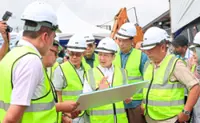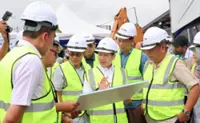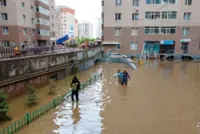The ruins of a house in Germany’s Ahr Valley destroyed by the disastrous floods that hit parts of western Europe in the summer of 2021. Photos: dpa
Tim Himmes is gradually rebuilding his parents’ house in Schuld an der Ahr, after the deadly flooding that hit parts of western Germany in the summer of 2021.
“It’s like living on a building site. You never finish,” says Himmes, 23, referring to concrete slabs he is planning to use to pave the path to the house.
Next, he will turn his attention to the barn. He’s also getting ready to lay the electricity cables underground.
He and his family ran a fairground, before the catastrophe. Right now, they focus on repairs, like so many in the region.
Around 9,000 houses were wrecked in the floods, which caused the Ahr River to rise 6m. Parts of Belgium and the Netherlands were also badly affected by the high waters.
The Himmes family is still waiting hopefully for a fibre optic connection. “They promised us that a long time ago, about a year after the flood,” he says, laughing.
Much remains to be done, even two-and-a-half years after the disaster, which claimed 243 lives in the Ahr valley, to the south of Bonn, and 49 more elsewhere in the German state of North Rhine-Westphalia.
But many are exhausted.
The effects of the devastating floods on people’s mental health are “massive and long-term”, says Sabine Maur, President of the State Chamber of Psychotherapists.
Many residents of the Ahr Valley are burdened “by the long duration of the reconstruction, the ongoing construction sites, the protracted disputes with authorities and insurance companies, the ongoing financial and family worries,” she says.
“Nothing can be done quickly and unbureaucratically here. That was the case three or four weeks after the flood, when nobody was around,” says hotelier and restaurateur Wolfgang Ewerts. “I feel as exhausted as an old cleaning rag. I’ve never been so flat,” says Ewerts, who has rebuilt his home and business in Insul since the flood. He is still investing.
“The booking situation is good,” he reports, with many of the guests asking, “Did you also have flooding here?”
When he hears that, he shows them the screen above the reception area, which runs photos in a continuous loop.
They show how volumes of water devastated his inn and beer garden on the river that fateful July when the Ahr burst its banks, sending water gushing through the streets.
Muddy brown waters rose relentlessly through people’s houses. People and their furniture were swept far from their homes. Cars were washed down cobbled roads and flipped into the river.
Bridges were torn away, and the bridge in Insul is still missing, says Ewerts. “But a lot is already back, many ruins are gone, and much is more beautiful than before.”
That varies, though, and little has changed on the central square on the Ahr in Schuld. The piles of stones and huge wooden cable drums suggest that progress is likely soon, though.
Builders are working on new houses or restoring older ones in the village. But there are also buildings filled with silt that were wrecked after the flooding but abandoned ever since.
These days, post-traumatic stress disorders have become more rare but the number of people suffering from depressive illnesses and addictions is rising, says psychotherapist Maur.
Some people seek help but often wind up having to wait far too long for a place in therapy, she says. Many also “perhaps initially thought they could cope on their own or were unsure about therapy”.
Gerd Gasper has been back in his completely renovated house in Altenburg since late autumn 2022. Builders are just finishing up the courtyard and everything should be ready in a few weeks.
Other people are also slowly returning to the Altenahr district, but the 82-year-old says what is missing are young people. “And everyone is busy with themselves.”
Houses are still being demolished in the village, so what you see are tiny houses that function as temporary accommodation – and construction cranes.
Gasper is not complaining – he has been pitching in, ever since the disaster. “I lost heart at times,” he concedes. But now he is confident again and is caring for his wife, now wheelchair-bound, likely due to the rescue operation involving a helicopter winch the afternoon after the flood.
That day, Gasper was in the attic. After hours spent in distress, the water rising, he found a brightly coloured Carnival scarf and waved it to a pilot to draw attention to himself and his wife through the window. “The water stopped three steps short of the attic.”
This January’s constant rain on the Ahr and the images of flooding in northern and eastern Germany did not frighten Gasper and hotelier Ewerts, both of whom have lived in the idyllic Ahr Valley for decades.
“The Ahr kept itself in check,” says Gasper. The floods in the north are bad for those affected, but very different, says Ewerts. “It comes slowly and goes slowly.”
On the Ahr, that summer, the floods were sudden and came with enormous force.
What upsets Ewerts is that some municipalities are no longer allowed to set up carnival tents on the Ahr as they used to because it is in the flood zone. “If there’s another flood like that here, nobody will be sitting in a tent.”
Himmes says after watching the images of flooding elsewhere in Germany, his family packed up the essentials and fixed trailers to the cars to be ready to flee just in case. “So that we could get away quickly.”
The muddy and smelly body of water not only flooded the family’s house and yard in the summer of 2021, but also took the fairground’s cars and rides with them. “If that happens again, we’ll all be gone.” – dpa/Ira Schaible








